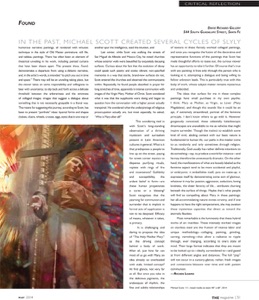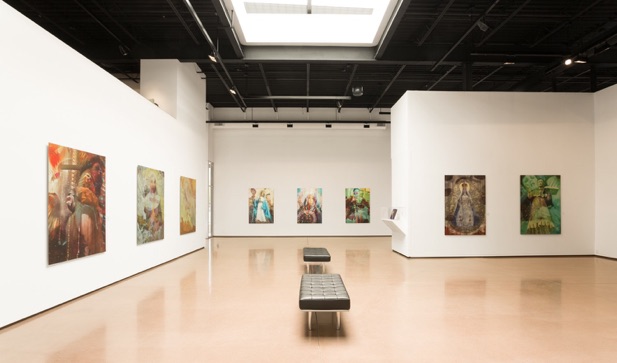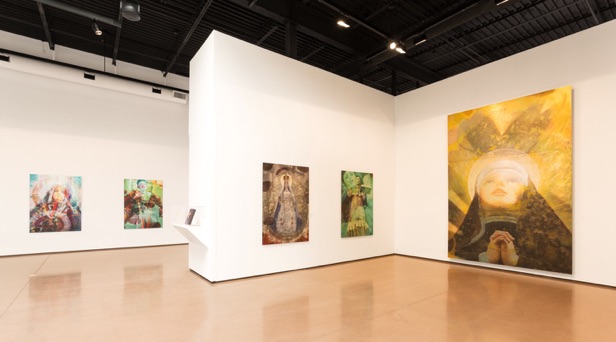THE Magazine April 2014

IN THE PAST, MICHAEL SCOTT CREATED
SEVERAL CYCLES OF SLYLY
humorous narrative paintings, all rendered with virtuosic
technique in the style of Old Master portraiture, still life,
and tableau paintings. There has often been an element of
theatrical unveiling in his work, including painted curtains
that have been drawn apart. This present show, Found,
demonstrates a departure from using a didactic narrative,
and, in the artist’s words, is intended “to pitch you out in time
and space.” There may still be an unveiling taking place, but
the viewer takes on some responsibility and willingness to
bear with uncertainty; to slip back and forth across a delicate
threshold between the arbitrariness and the strictness
of collaged images; images that suggest a dialogue about
something that is not necessarily graspable in a literal way.
The means for suggesting this journey, according to Scott, has
been to present “porthole” ideas: layered forms and shapes
(haloes, chains, wheels, crosses, eggs, eyes) that in one way or
another spur the intelligence, seed the intuition, and
Last winter, while Scott was walking the streets of
San Miguel de Allende and Mexico City, he noted churches
whose exterior walls were beautified by exquisitely decaying
surfaces. Curious about the fact that the evolution of decay
could speak such poetry and evoke vibrant, non-specified
memories in a way that sterile, brand-new surfaces do not,
Scott entered the churches and observed the communicants
within. Repeatedly, he found people absorbed in prayer for
long stretches of time, apparently in intense communion with
images of the Virgin Mary, Mother of Christ. Scott wondered
what it was that the supplicants were doing and began to
question how the conversation with a higher power actually
transpired. He wondered what the underpinnings of religious
preoccupation actually are, but most especially, he asked,
“Who is Mary after all?” This wondering tied in with Scott’s
long-standing observation of a thriving mysticism and surrealism
present in Latin American cultures in general. What is it
that predisposes a people to line up on the street, paying
for street corner mystics to dispense purifying rituals,
replete with rings of fire and incantations? Gullibility
and susceptibility, the ardent belief in form—are these human
propensities a curse or a blessing? Scott recognizes that the
yearning for communion and surrender that is implicit in
formal acts of supplication is not to be despised. Efficacy
of means, whatever it takes, is primary. It is challenging and
daring to propose the idea of “The Holy Mother Mary”
as the driving concept behind a body of work. After all, just how
far can most of us go with Mary, an idea already so overloaded
with stale, limited concept? At first glance, not very far
at all. But once you take in the delicious pigments, the
arabesques of rhythm, the fine and subtle relationships
of texture in these fiercely worked collaged paintings,
and once you recognize the fusion of the decorative and
representative functions of the paintings that Scott has
made thoughtful efforts to tease out, the curious viewer
has an opportunity to take it further. Of course that’s true
with any painting: it lives only through the person who is
looking at it, attempting a dialogue and being willing to
follow unknown leads. This is particularly true with this
body of work, whose subject matter remains mysterious
and undecided.
The ideas that surface for me in these complex
paintings have small purchase in my own psyche.
I think: Mary as Mother, as Virgin, as Lover (Mary
Magdalene), and though this sounds like it could be an
apt, if extremely streamlined, portrait of the feminine
principle, I don’t know where to go with it. However
gorgeously conceived, these celestially kaleidoscopic
dreamscapes are unavailable to me as vehicles that might
inspire surrender. Though the instinct to establish some
kind of vivid, abiding contact with our basic nature is
fundamental to human life, our paths in this matter come
to us randomly, and only sometimes through religion.
Traditionally, God usually has rather definite intentions to
do something—say, to produce a world for instance—and
he may therefore be unnecessarily dramatic. On the other
hand, the manifestations of what are loosely labeled as the
feminine aspect tend to be more accidental and playful,
or embryonic: it embellishes itself, puts on make-up; it
expresses itself by demonstrating some sort of glamour,
whatever it may be: passion, aggression, seduction, loving
kindness, the sheer ferocity of life... attributes churning
beneath the surface of things. Maybe that’s what people
will find so compelling about Mary in these paintings:
her all-accommodating nature invites scrutiny, and if one
happens to have the right temperament, she may awaken
those mysterious capacities that direct us toward the
eternally flawless.
Most remarkable is the luminosity that these hybrid
works of art manifest. These intensely worked images
on stainless steel are the fruition of intense labor and
unique methodology—collaging, painting, grinding,
carving, varnishing—that allow a radiance to ripple
through, ever changing, according to one’s state of
mind. Their large format indicates that they are meant
to be looked up to—ideally, surrendered to—and gazed
at from different angles and distances. The full “pop”
will not occur in a cursory glance; rather, fresh images
and connections blossom over time and with patient
communion.
—Richen Lhamo




